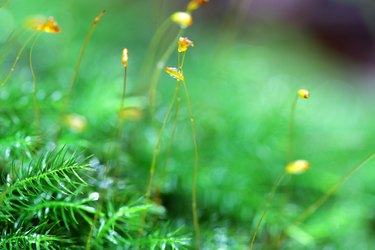
If you search for "moss" on the internet, you are likely to find more info about getting rid of it than taking care of it. Yet the moss-not-grass movement is taking hold, and this low-growing plant that has been on the planet for 450 million years is moving up the popularity ladder. Homeowners are discovering the many benefits of replacing a traditional grass lawn with moss. If you are considering inviting moss into your yard, you may be happy to have some questions answered.
What, Exactly Is Moss?
Video of the Day
Moss is a a dense, low-growing plant that grows close together in large numbers, spreading like a carpet over soil -- and also over trees, rocks and other objects. It thrives in moist environments and requires generous amounts of water to stay lush and green. Different species of moss require different amounts of irrigation.
Video of the Day
How Many Species of Moss Are There?
More than 9,000 species of mosses grow on the planet, including some 1,200 species found in the United States and Canada. Common species in this country include granite mosses (Andreaea spp.) and peat mosses (Sphagnum spp.)
How Is Moss Different From Other Plants?
Mosses are different from familiar garden plants in many ways. They have rhizoids instead of regular roots. Also, they do not bear flowers, but reproduce by branching and fragmentation. Unlike flowering plants, mosses have a life cycle called alternation of generations that includes two phases, when the moss grows as sporophytes and as gametophytes.
Where Do Mosses Thrive?
You may have seen moss in forests at the bases of trees and other moist and shady places. Some mosses prefer growing in or near lakes, ponds and rivers. One of the important parts of caring for moss in your garden is providing adequate irrigation during dry periods. Most mosses won't do well in hot sun.
What Does Moss Need to Grow Happily?
For moss, water is a source of humidity and also a source of nutrients. Don't give your moss tap or hose water, which may be too high in calcium or chlorine. If your moss browns or looks dry, switch to distilled water or natural rainwater to irrigate it. And be certain you don't use chemicals on nearby plants that could travel with rainwater or irrigation into the moss. Other than proper irrigation, moss is consistently easy to maintain, as long as you install it in an area with partial or full shade.
Why Install Moss Instead of Grass?
Moss has a lot going for it as a ground cover. It thrives in shade, which grass doesn't, but won't grow in hot sun. It grows fast, stays low to the ground, and grows so densely that it keeps weeds down and prevents erosion. It thrives in low-quality, acidic soil, requires a fraction of the water that grass demands and can be walked on without damage. And some people find a lush mat of moss to be romantic and even magical.